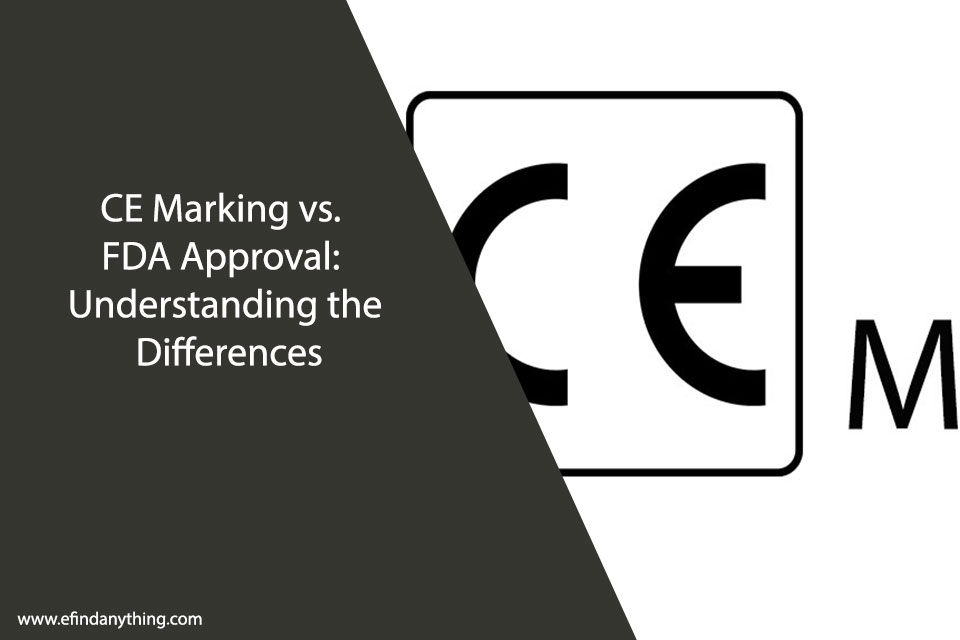There are two major regulatory pathways for ensuring that medical devices are safe and effective for consumers: CE Marking and FDA Approval. Both systems have similar goals but differ in process, requirements, and geographical reach. Understanding the nuances of each is crucial, especially if you’re navigating the global market. Whether you’re a manufacturer, healthcare professional, or consumer, knowing the difference can significantly impact how medical devices are distributed and used.

Table of Contents
What is CE Marking?
CE Marking is a certification indicating that a product complies with European Union regulations. CE approval for medical devices is a key part of this process, ensuring that the device meets EU safety standards. To get this approval, manufacturers must undergo a detailed process and demonstrate the device’s conformity to the relevant European directives and regulations.
Unlike the FDA, CE Marking allows manufacturers to self-certify many devices, especially lower-risk products. The process, while detailed, offers manufacturers flexibility in the route to market. Once approved, the CE Mark is affixed to the device, allowing it to be sold across the EEA.
FDA Approval: A Different Standard
The FDA approval process for medical devices in the United States is much more stringent and involved. The Food and Drug Administration (FDA) evaluates the safety and effectiveness of medical devices before they are sold in the US market. This data helps to assess whether the device’s benefits outweigh its potential risks.
The FDA approval process can be lengthy, often taking months or even years, depending on the device’s classification. It categorizes devices into three classes, with Class III devices requiring the most intensive review. Unlike the CE Marking system, the process involves substantial paperwork, testing, and sometimes substantial cost.
Key Differences in Regulatory Processes
The differences in the regulatory approach become evident when comparing CE marking to FDA approval.
Flexibility for Manufacturers:
- CE Marking generally offers more flexibility, especially for low-risk devices.
- The process often doesn’t require as much direct involvement from third-party organizations.
Centralized FDA Approval Process:
- FDA approval is highly centralized and has strict guidelines.
- It requires clinical studies, animal testing, and rigorous data analysis.
Regulatory Involvement:
- CE Marking allows self-certification for specific devices.
- FDA approval requires direct interaction with the FDA, including presenting significant safety and performance evidence.
Complexity and Cost:
- FDA approval is more complex and costly, particularly for high-risk appliances.
- CE Marking may be less costly due to fewer requirements for third-party involvement.
Global Market Impact: CE vs. FDA
The global market is increasingly interconnected, with CE Marking and FDA approval playing pivotal roles. If a manufacturer seeks to introduce a product in Europe, CE approval for medical devices is a must. Meanwhile, FDA approval is non-negotiable for the US market. Companies aiming for a broader reach will often go through both processes, although they must adapt to different regulatory requirements.
Exploring both CE and FDA approvals can be challenging for businesses looking to scale globally. There are differences in documentation, timelines, and even testing protocols. Some manufacturers even choose to develop separate versions of their products for each market to meet the specific regulatory requirements of the EU and the US. This adds complexity and cost to the manufacturing process but ensures compliance in both regions.
Both CE marking and FDA approval protect consumers and ensure that medical devices are safe and effective. If you’re looking to distribute in the European Union, CE approval for medical devices is essential, while FDA approval is crucial for those targeting the US market. Ultimately, the choice between the two depends on where you plan to sell your product and the type of device you’re manufacturing.





